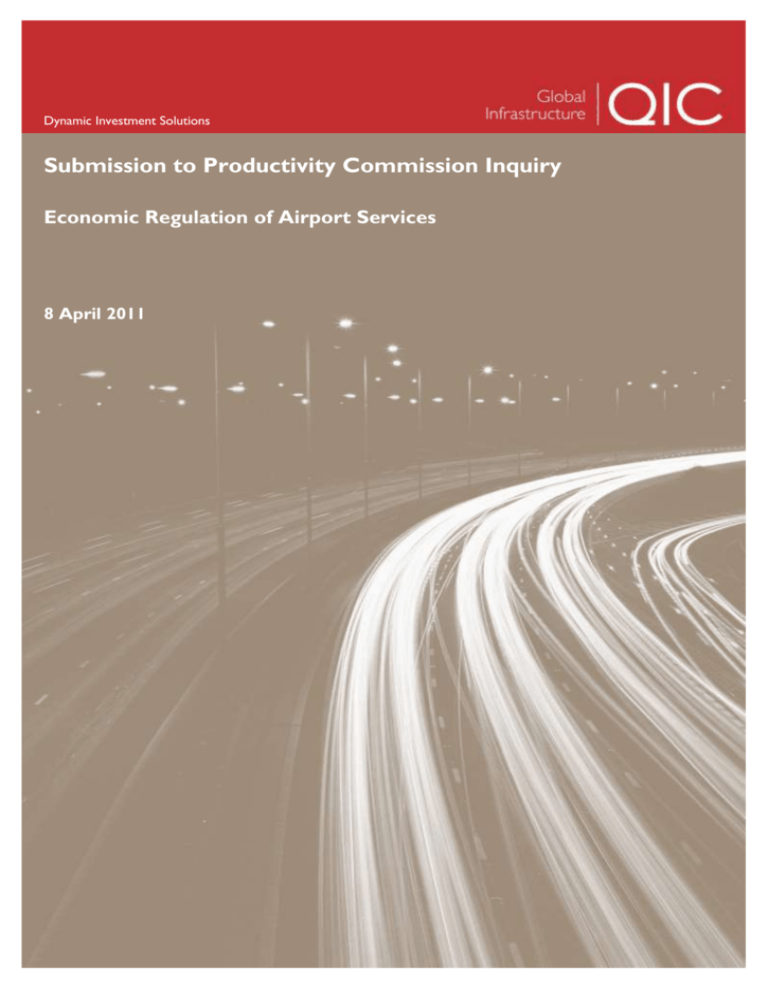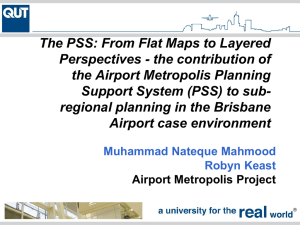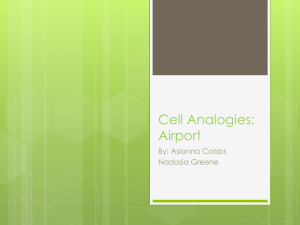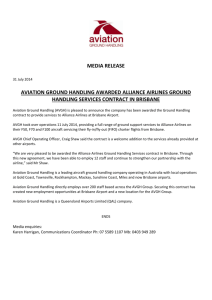
Dynamic Investment Solutions
Submission to Productivity Commission Inquiry
Economic Regulation of Airport Services
8 April 2011
Table of Contents
1.
Summary ......................................................................................... 3
2.
Background to QIC Global Infrastructure ................................... 3
3.
Need for Superannuation Fund Investment ................................ 4
4.
QIC Investment Framework ......................................................... 4
4.1 Infrastructure Generally ........................................................................................................................4
4.2 Airports .....................................................................................................................................................5
4.3 Brisbane Airport .....................................................................................................................................6
5.
The Current Regime ...................................................................... 7
QIC Limited ACN 130 539 123 (“QIC”) is a company government owned corporation constituted under the Queensland
Investment Corporation Act 1991 (Qld). QIC is regulated by State Government legislation pertaining to government owned
corporations in addition to the Corporations Act 2001(Cth) (“Corporations Act”). QIC does not hold an Australian financial
services (“AFS”) licence and certain provisions (including the financial product disclosure provisions) of the Corporations Act do
not apply to QIC. Please note however that some wholly owned subsidiaries of QIC have been issued with an AFS licence and are
required to comply with the Corporations Act. QIC Global Infrastructure (“QIC GI”) is a business division of QIC Limited.
QIC, its subsidiaries, associated entities, their directors, employees and representatives (“the QIC Parties”) do not warrant the
accuracy or completeness of the information contained in this document (“the Information”). To the extent permitted by law, the
QIC Parties disclaim all responsibility and liability for any loss or damage of any nature whatsoever which may be suffered by any
person directly or indirectly through relying on the Information, whether that loss or damage is caused by any fault or negligence of
the QIC Parties or otherwise. The Information is not intended to constitute advice and persons should seek professional advice
before relying on the Information.
Copyright QIC Limited, Australia 2011. All rights are reserved. Do not copy, disseminate or use, except in accordance with the
prior written consent of QIC.
2
1. Summary
QIC Global Infrastructure (“QIC GI”) is pleased to make a submission to the Productivity Commission in
relation to the public inquiry into the Economic Regulation of Airport Services. QIC GI, on behalf of its
clients, is a significant investor in Australian infrastructure and in particular, is the largest single shareholder
in Brisbane Airport Corporation (“Brisbane Airport”) holding a 25% equity interest. QIC GI supports
the views made by Brisbane Airport in its submission to this inquiry, but would like to specifically note the
following:
Certainty, stability and transparency in the regulatory regime for airports is a pre-requisite to promote
investor confidence in this sector and in Australian infrastructure as a whole;
Our expectation at the time of assuming the asset management of a 25% interest in Brisbane Airport
was for the light handed regulatory regime to continue and in particular, that car parking would not be
regulated;
The current light handed regulatory regime provides for the efficient and successful management of
Australia’s aeronautical infrastructure and specifically, has delivered significant investment, improved
airport/airline relationships and had a positive impact on service quality. As such, there is no
justification to re-regulate or make any changes to the current regulatory regime; and
Given the significant investment required at Brisbane Airport (in particular $1.3bn, over the next eight
years, in respect of the second runway), it is critical that a return is provided as the investment is made.
Otherwise, it will be extremely difficult to raise debt and equity for large projects such as the new
runway.
QIC GI on behalf of our clients is a long term investor in Australian infrastructure and we look forward to
a regulatory regime that allows us to continue to make further investments in the Australian airport sector.
2. Background to QIC Global Infrastructure
QIC GI is a business division of QIC Limited (“QIC”), a leading institutional funds manager with $55.9
billion in funds under management as at 31 December 2010.
Established in 2006, QIC GI is a dedicated infrastructure team specialised in sourcing, investing and
managing infrastructure investments globally. Since commencement of the infrastructure program, QIC GI
has successfully invested and committed over $3.1 billion of our clients’ infrastructure allocation into a
global portfolio of 14 infrastructure investments over 12 geographies. QIC GI has a strong record of
investing in Australia’s national infrastructure having made the following investments:
Brisbane Airport Corporation (2007) – 25% equity interest;
Westlink M7 Tollroad (2009) – 25% equity interest; and
Port of Brisbane (2010) – 26.67% equity interest.
QIC GI’s major clients are Queensland based public sector superannuation funds which represent a
significant portion of Queensland households. These Australian clients are and will continue to be a
significant source of investment in Australian infrastructure.
3
3. Need for Superannuation Fund Investment
Infrastructure is the key to how Australia does business, how we meet the needs of a prosperous economy
and growing population and how we sustain a cohesive and inclusive society1. However, the private sector
and the Australian governments face a significant challenge to finance and deliver the infrastructure that will
underpin the continued economic growth and social development in Australia. This predicates a need to
involve superannuation funds in meeting the anticipated funding gap. The Australian superannuation
industry is one of the largest savings pools in the world with the industry being charged with matching
assets to meet the liabilities of all working Australians in their retirement. Infrastructure assets are
particularly attractive in building a diversified portfolio of assets to meet these superannuation liabilities.
Infrastructure assets provide long-term, inflation linked, stable and strong returns. They are typically
essential assets in the energy, transport and social sectors which are regulated by the Government or
independent statutory bodies. It is an imperative for governments to offer a risk-return profile that closely
matches the expectations of superannuation funds and their managers in order to encourage investment by
these funds. For superannuation funds and their members, there exists a virtuous circle investing in
infrastructure. The members by investing in infrastructure get long life assets with an attractive risk return
to support their retirement while also benefiting from the utility of well funded developed infrastructure
(eg an airport). Of critical importance in this virtuous circle is a stable, transparent and certain regulatory
regime for superannuation funds so that they can make long-term investment decisions. This not only
applies to domestic superannuation funds but also international pension funds who have a desire to expand
their direct infrastructure investment in Australia. Regulatory uncertainty is a major barrier to investment
in infrastructure, particularly for overseas investors.
4. QIC Investment Framework
4.1 Infrastructure Generally
Although infrastructure assets provide a strong match for superannuation funds, the return on the
investment needs to be commensurate with the associated risks.
QIC GI views infrastructure investments on the basis of its ‘lifecycle’, as assets in the same sector can
display different risk/return profiles depending on their lifecycle stage. In increasing order of riskiness, the
categories that QIC GI considers are Core, Core Plus (or value added) and Opportunistic. These
classifications determine the minimum return that QIC GI will seek when making an investment:
Category
1
Risk / Return Characteristics
Infrastructure Partnerships Australia, The Role of Superannuation in Building Australia’s Future, April 2010.
4
Core (C)
• Mature infrastructure
• Assets governed by stable certain and transparent regulatory regimes, or which have substantially
contracted revenue streams
• OECD countries
• Low asset and financing risk
Core Plus (CP) (or value
added)
• Developing infrastructure
• Assets with revenue growth from increased volume, or patronage driven by significant expansion capital
expenditure or operating improvement
• Regulatory certainty
• OECD countries
• Intermediate asset and financing risk
Opportunistic (O)
• Greenfield infrastructure
• Capital intensive assets operating in competitive market environments
• Non-OECD countries
• Potentially higher asset and financing risk
4.2 Airports
QIC GI views airports generally as a core plus asset. The key value drivers that we consider when
assessing a potential airport investment are detailed below:
Revenue Split
- Diverse between aero, retail and carparks
- Land bank attractive
Traffic Mix
Diverse airline, type of travel (visiting family
and friends, business, leisure) and mix
(domestic vs international) preferred.
Capital Expenditure
Preferably limited capital expenditure
Airport Key
Considerations
Regulation
Regional
Economy/Traffic
Performance
Management
- Dual till preferred (vs single till)
- Low regulatory risk
- Growth and traffic has shown resilience
through cycles
- Low political risk
Strong management team with track record
QIC GI considers it attractive for an airport to have a diverse mix of revenues between aeronautical, retail
and carparking. It is also preferred for airports to have a diverse mix of airlines, type of travellers and
domestic/international split. This diversity provides protection against other airport risks as detailed below.
Capital expenditure is necessary in order to service increasing numbers of passengers or to replace ageing
infrastructure. It is preferable for this expenditure to be limited or for a regulatory regime to be in place
which provides an appropriate return for investors as the expenditure is expended.
5
QIC GI supports a light handed regulatory regime with appropriate protections for users, whilst also
allowing the airports to undertake their business in an efficient manner and providing an appropriate return
on investment for investors. These protections must take account of the security and safety requirements
that users expect in using airports. If a detailed regulatory regime were to exist, QIC GI supports a dual till
regime. This regime would allow airports to provide regulated services under an agreed price and quality
framework whilst encouraging investment in unregulated non-aeronautical services where it is commercially
viable to do so.
Over the long term, traffic growth has been positive at most airports as traffic has a strong correlation to
GDP. GDP and many other factors impact traffic including the AUD exchange rate, airline capacity, real
income levels, airline ticket prices and fuel prices. There is therefore considerable potential volatility. More
recently, these factors have negatively impacted demand with demand slowing or turning negative in certain
regions. Travel through gateway airports has a significant international element and therefore, airports are
part of the global network of airline routes and schedules. This means that airports do have a higher
exposure to shocks and risks than a regional centred infrastructure asset like a local electric or gas utility.
Further, the overall aviation market is dynamic and is currently undergoing significant change. Developing
markets are leading the charge with strong growth especially in India, China and Brazil. Low cost carriers
are aggressively growing capacity (eg Tiger, AirAsia, Strategic Alliance), with such competition continuing to
provide demand stimulus and growing the underlying market for air travel. Combined with the increase in
the number of domestic airlines (eg Etihad), the price of domestic discount air fares has also declined which
has helped growth but fuel prices remain high and volatile.
Since commencing our infrastructure investment programme in 2006, QIC GI has reviewed investments in
22 airports in 9 countries. QIC GI has only one airport investment being Brisbane Airport. However,
there is currently a strong pipeline of global airport investment opportunities available principally in Europe
and the UK which we are considering.
4.3 Brisbane Airport
In 2007, when assuming on behalf of our clients the asset management of their interests in Brisbane
Airport, QIC GI considered that the following associated risks would affect their expected return:
1. Significant Capital Expenditure
Brisbane Airport requires a significant investment of capital to build the infrastructure it requires to
service the expected growth in passenger numbers. This capital expenditure program (which includes
the building of a new runway and terminal upgrade) will likely add stress to the company’s financial
profile and may potentially reduce its financial flexibility. The capital expenditure program will also have
associated construction and project risk which will demand an increase in return for our clients. A
commitment to this capital expenditure cannot be made without a predefined revenue arrangement.
2. Periodic External Shocks
Brisbane Airport is exposed to periodic external “shocks” relating to the aviation industry (eg Swine
flu, volcanic ash disruptions, September 11 attacks). More recently, Brisbane Airport has been affected
by the Brisbane flooding, Yasi cyclone, Christchurch earthquake and the Japanese tsunami. These will
impact aeronautical revenues, car parking and retail revenues and will put pressure on Brisbane
Airport’s financial metrics.
3. Economic conditions
Brisbane Airport is affected by economic conditions and in particular, the Queensland economy. The
Queensland economy is driven by resources and tourism, both which vary with global economic
6
conditions and weather. With a significant proportion of tourist travellers, Brisbane Airport is exposed
to the cyclical nature of holiday passenger demand which has softened recently.
4. Competitive Position
Unlike many of Australia’s other capital city airports, Brisbane Airport is more exposed to competition
from regional international airports, in particular from Gold Coast airport and to a lesser extent the
Sunshine Coast airport and Cairns airport. With international and domestic growth at Gold Coast
Airport being higher than Brisbane over the last few years, this competition may impact the timing and
rate of growth of Brisbane Airport.
QIC GI’s clients have not received any distributions from Brisbane Airport during the global financial crisis.
However, this cannot be sustained in the long-term as our clients require a yield on investment as opposed
to solely unrealised capital gains.
Fundamental to QIC GI’s investment in Brisbane Airport is the continued operation of the light handed
regulatory regime. In order for our clients to continue to commit funds to Brisbane Airport including
during this critical capital expenditure phase, our clients require:
-
a stable regulatory regime that allows a return commensurate with the considerable risks outlined
above;
-
certainty that any future investment will yield an appropriate return, and in particular in respect of the
$1.3 billion investment (in 2011$ terms) in the new parallel runway from the beginning of the
construction period which is estimated to last for 8 years; and
-
certainty that the regulatory framework will allow Brisbane Airport to raise attractive debt on a long
term basis. As detailed further in the Brisbane Airport submission, both Moody’s and Standard and
Poor’s have highlighted the risks to Brisbane Airport of a change from the current light handed
regulatory regime.
5. The Current Regime
The current light handed regulatory regime provides for the efficient and successful management of
Australia’s aeronautical infrastructure. In particular, Brisbane Airport has managed to keep aeronautical
fees and charges reasonable, whilst meeting or exceeding customer expectations and continually investing
in the infrastructure to ensure the facilities stay amongst the best in the world. Brisbane Airport has
achieved the highest rating airport for quality of service for the last 7 years under the ACCC’s monitoring
regime. As such, QIC GI sees no justification to re-regulate or make any significant changes to the current
regulatory regime.
Specifically, the current regime has not resulted in Brisbane Airport setting monopoly prices for
aeronautical services but rather facilitated an improvement in the airport/airline relationship for mutual
benefit. Unlike other infrastructure assets, airports’ few customers (ie the airlines) are large companies
that have demonstrated an ability to co-ordinate as an industry and are well informed and well equipped to
work with airports to agree mutually acceptable outcomes. This has allowed commercial negotiation and
7
agreements around a framework which is clear to both airports and airlines where pricing is based on
(effectively) historic written-down asset values plus capital investment as it occurs (and as agreed).
Importantly, pricing is a matter for commercial negotiation between airports and their users.
The current regime has also encouraged Brisbane Airport to continue to invest in non-aeronautical
infrastructure (including car parks and roads) in order to maintain the quality of service for its customers.
This involved the investment in late 2007 in an international terminal expansion ($320m) and major new
roads ($220m) when debt markets around the world collapsed. Brisbane Airport will also complete the
construction of a new multi-level car park at the Brisbane Domestic Terminal in November 2011. Car park
charges do not represent monopoly prices but rather reflect locational rent and are justified based on
Brisbane Airport earning a fair commercial return on this new investment. The investment in new car parks
has also increased the level of competition in a market where there is significant off-airport parking
facilities, rail access through Airtrain and competition from taxi services which provide real alternatives to
on-airport parking given the close proximity of the airport to Brisbane city. As noted in the ACCC
response to this review, Brisbane Airport has not attempted to restrict competition to on-airport car
parking by controlling the conditions of “front door” access to terminal facilities through the charging of
excessive levies to alternatives2.
Eighty-one per cent of Brisbane Airports’ shareholders are ultimately Australian superannuation and similar
funds. Therefore, any changes to the regulatory regime which may impact the financial performance of
Brisbane Airport will also affect the performance of these superannuation funds.
As an investor in infrastructure projects of significance to the community, it is important that there is a
stable, transparent and certain regulatory regime. Additional risk or the perception of risk arising from the
uncertainty around an asset’s regulatory regime will result in either a reduction of capital available for
investing in such assets or an increase in the returns demanded by that capital. This will impact not only
investments in new airports, but also the significant level of current investment at Australia’s existing major
airports. Tourism and Transport Forum Australia notes that this ranges from $60 million at Darwin
Airport to $2.2 billion at Brisbane Airport for a new parallel runway, international and domestic terminal
redevelopments and a northern access road3.
In the context of QIC GI’s portfolio allocation decision making, airports compete for capital against other
infrastructure investments and other airport investments globally. The low double digit returns for
Brisbane Airport are in line with other infrastructure assets within our portfolio with the same risk
characteristics. However, it is critical that a stable, transparent and certain regulatory regime exist in order
to encourage further active involvement by QIC GI in the Australian airport sector relative to other
sectors both in Australia and globally.
2
3
Australian Competition & Consumer Commission, Submission to the Productivity Commission’s inquiry into the economic regulation of
airport services, March 2011
Tourism & Transport Forum Australia, Annual Review of Regulatory Burdens on Business: Social and Economic Infrastructure Services, July 2009
8










